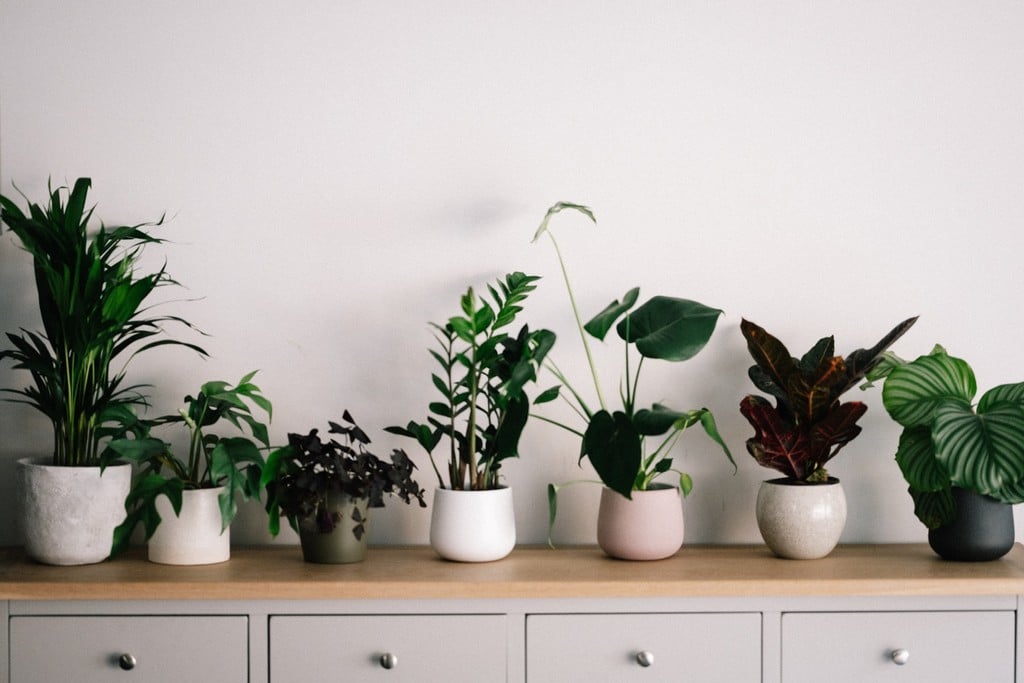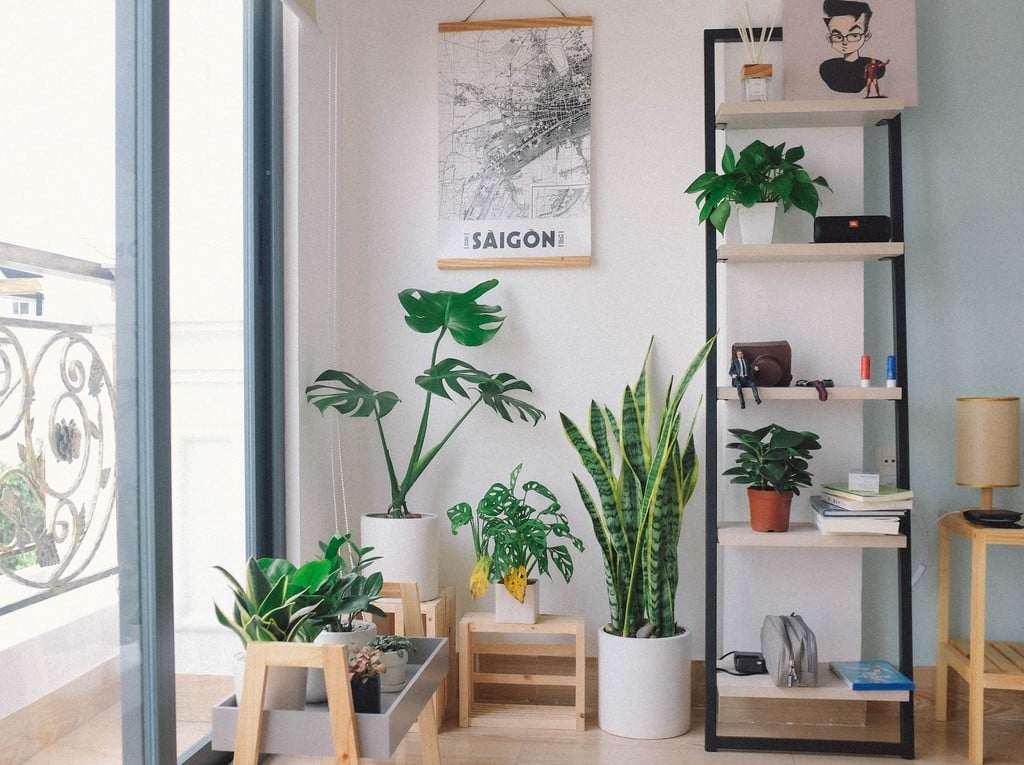In this article:
- Financial benefits of houseplants
- Health benefits of houseplants
- Basic plant care
- Houseplants for every room
- Decorating your home with indoor plants
Adding houseplants to your interior and taking care of your landscaping is one of the best ways to increase the value of your property. Aside from excellent health benefits, your house also becomes more attractive to a potential buyer.
Plant decor is one of the most efficient ways to add value to your home without spending a fortune on upgrades like furniture and decor. You can easily breathe new life into your property by adding things like a plant wall or vertical garden.
Financial benefits of houseplants
Indoor plants
Houseplants have become very popular in the last few years. But besides their health and design qualities, houseplants add more value to your home. Plants work great for staging – a practice that can help make a property more attractive to a potential buyer.
Houseplants create a feeling of warmth and comfort. If you want your place to look cozier, add some greenery. The homey atmosphere is particularly appealing to home shoppers, and houseplants are your best tools for achieving it without spending a fortune on home design upgrades.
Outdoor plants
Outdoor plants are a good investment that doesn’t require a significant budget. They help you increase your privacy, create more green space, and appeal to your property.
According to the 2018 Modeling Impact Report: Outdoor Features by the National Association of Realtors, lawn care services return 267% of the investment. Landscape maintenance and tree care are a break-even proposition, returning 100% of the investment.
Plants that can help increase your home’s value
While trees are known to add value to your property, they don’t always work the same, depending on where you live. If you live in a cooler climate, don’t add palm trees to your backyard—plant maple trees, pine trees, oaks, and other deciduous types that can handle cold winters.
On the other hand, if you live in a warm climate, it makes sense to plant palm trees, fruit trees, magnolias, and any trees that produce big blossoms. You can even start a small orchard.
Studies have shown that having well-maintained trees and flowerbeds around your property has a much bigger return on your investment than other additions like a swimming pool.
Health benefits of houseplants
Reduces stress level
A 2007 study found a bacterium in plant soil called Mycobacterium vaccae that triggers the release of serotonin, which lifts mood and reduces anxiety. It means that interaction with indoor or outdoor plants can alleviate symptoms of depression.
Boost your mood and productivity
According to a study from Washington State University, people with plants in their workspaces feel more productive and had a 12 percent faster reaction time on computer tests than those without plants.
Boost healing
When you have plants around, you have more nature. Watching your plants grow provides a sense of optimism and curiosity, which makes you focus on new topics and creates a calm feeling. This is especially true for students who are studying away from home and wish to feel more comfortable in student accommodations.

Basic plant care
Make sure they like their spot
After you get your plant, you need to figure out the right spot for it in your house. A garden planner may be utilized to help you plan the plant’s location. If your plant gets too little or too much sun, it can quickly start withering or showing other signs of illness. When you get a plant, research where to put it and experiment with several spots on your house. This is vital when caring for your houseplants.
Water them properly
Watering plants can be tricky. If you want too much, your plant can start drowning. And, if you water too little, they can quickly dry up and even die. To keep your plants happy, you need to find a balance.
Most plants prefer dry soil between watering sessions, but some prefer wet soil. To find out whether a plant needs water, check the ground near the edge of the pot. If the soil is dry and crumbly, you should water the plant. And if it’s damp, wait until next time.
Be aware of pests
Outdoor plants have a high risk of being eaten by squirrels, rabbits, and other animals who like to nibble on greenery. To reduce the risk of having your plant eaten by an uninvited guest, put them in a place that can’t be easily accessed. A screened porch is a great spot, but if you don’t have one, try hanging baskets. They are hard to reach for most animals and allow your plants to get more sunshine.
Kids’ and pets’ safety
Some plants can be toxic for pets and kids if ingested, so if you have pets and kids in your home, choose safe plants. Think about a safe place for your plants. While pets love your plants, they also might damage or even destroy them since they often see them as something to chew on.
Choose a plant that fits your lifestyle
Choosing a plant that fits your needs and lifestyle doesn’t take an expert in gardening. All you need to do is to select the species that fit your lifestyle. For example, choose cacti, bamboo, or spider plants if you want a plant for your home office. Another alternative is to try plants like orchids or violets that produce gorgeous blooms.
Make sure they are the right fit for your house
When choosing a house plant, consider the size of your home. Plants need enough space to stay healthy and grow.
Bigger plants are more suitable for larger homes because it allows them to have enough space and light. If you live in a small condo or apartment, don’t try to cram a big houseplant in a small space. A better alternative is to get small or medium-sized plants that could serve a specific purpose and add more atmosphere to your place.
Keep houseplants in the right pot
Drainage is one of the essential parts of taking care of your house plant. Whenever you get a new house plant, buy a pot with a hole at the bottom so that all the water can drain properly into a tray underneath.
If a pot doesn’t have a hole for draining water, your plant could “drown” in excess water. For some plants, like cacti, the excess water could cause root rot. If your plant looks droopy and loses its leaves, there’s a chance that the plant is too wet because of the drainage problem.
Houseplants for every room
When choosing houseplants for different parts of your house, keep in mind your home’s aesthetic and the required care for your plants. Plants have varying needs when it comes to sun exposure, humidity, and temperature. Not every plant can survive a room without windows. Likewise, some plants prefer indirect sunlight.
- Kitchen – The kitchen is a great spot to plant ferns, air plants, and other species that like moisture. Herbs are an ideal option for the kitchen; a combo of sage and cilantro can work well in a sunny cook space.
- Bedroom – Your bedroom is your resting place and is supposed to create a peaceful atmosphere that helps you to relax. Add a spider or snake plant to reduce anxiety and boost your mood.
- Living room – Your living room is perfect for big, bold plants that can make a statement and add to the overall atmosphere. It’s an excellent place to display succulents, begonias, or rubber trees.
- Bathroom – The bathroom is the most humid place in the house, and the plants you get should be similar to those in a tropical environment – with high humidity, warm temperatures, and low light. Ferns and air plants do well in this environment.
- Home office – A home office is where you have a lot of electronics and low-to-medium light. Cacti are one of the most popular home office choices, but others include the Jade plant and begonia.
- Patio/backyard – For your patio, choose plants that require the most direct sunlight and can also create a welcoming environment for your guests. It’s a perfect spot for bigger, light-intensive plants like caladium, hydrangea, ornamental plants, and plants with big blossoms like fuchsia.

Decorating your home with indoor plants
- Plant Wall – Also known as a vertical garden, a vertical plant wall can breathe new life into your living space. It’s also a great complement to your artworks or bookshelves. Favorites for plant walls include fast-growing philodendron, pothos, and ferns such as medusa.
- Crawling vines – Crawling vines help to camouflage parts of your home that you want to obscure. A creeper grows very low to the ground or close to a wall or fence. For example, English Ivy is an evergreen plant that provides privacy. Many types of ivy and other vines are creepers.
- Terrariums – These are low-maintenance, space-saving, beautiful, and work well for small spaces. A terrarium is an excellent addition to your home, and you can plant various plants there, like bonsai trees and small junipers.
- Hanging planters – These are an excellent way to spruce up your backyard, a front porch, or add more color to your patio. Some popular options are ferns, burro’s tail, moss rose, and petunia.
- On stands and shelves – Placing a couple of flower pots on racks and shelves throughout your house can help add more ambiance to your home. Pothos, rubber plants, and fiddle leaf figs are some of the most popular choices.
- As centerpieces – Plants are often used as centerpieces in places like living and dining rooms and hallways where most activity happens. Potted plants work the same way as freshly cut flowers but last much longer.
The final word on using houseplants to increase your home value
Houseplants are eye-catching and budget-friendly options that can freshen up your living space. They also work well for staging your house and create more visual appeal for potential buyers with little investment. Whether you want to get your property ready for the market or upgrade your interior design, adding a couple of plants is the best way to achieve the result.

